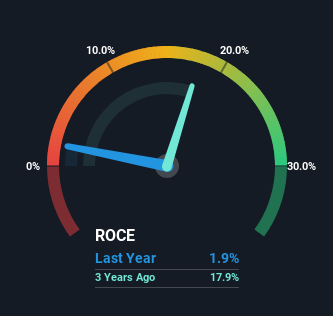- South Korea
- /
- Metals and Mining
- /
- KOSDAQ:A060380
Investors Met With Slowing Returns on Capital At Dongyang S.TecLtd (KOSDAQ:060380)
If we want to find a stock that could multiply over the long term, what are the underlying trends we should look for? Ideally, a business will show two trends; firstly a growing return on capital employed (ROCE) and secondly, an increasing amount of capital employed. If you see this, it typically means it's a company with a great business model and plenty of profitable reinvestment opportunities. However, after briefly looking over the numbers, we don't think Dongyang S.TecLtd (KOSDAQ:060380) has the makings of a multi-bagger going forward, but let's have a look at why that may be.
Return On Capital Employed (ROCE): What Is It?
For those who don't know, ROCE is a measure of a company's yearly pre-tax profit (its return), relative to the capital employed in the business. To calculate this metric for Dongyang S.TecLtd, this is the formula:
Return on Capital Employed = Earnings Before Interest and Tax (EBIT) ÷ (Total Assets - Current Liabilities)
0.019 = ₩2.4b ÷ (₩183b - ₩54b) (Based on the trailing twelve months to June 2024).
Thus, Dongyang S.TecLtd has an ROCE of 1.9%. In absolute terms, that's a low return and it also under-performs the Metals and Mining industry average of 5.2%.
See our latest analysis for Dongyang S.TecLtd

Historical performance is a great place to start when researching a stock so above you can see the gauge for Dongyang S.TecLtd's ROCE against it's prior returns. If you want to delve into the historical earnings , check out these free graphs detailing revenue and cash flow performance of Dongyang S.TecLtd.
How Are Returns Trending?
In terms of Dongyang S.TecLtd's historical ROCE trend, it doesn't exactly demand attention. The company has employed 82% more capital in the last five years, and the returns on that capital have remained stable at 1.9%. Given the company has increased the amount of capital employed, it appears the investments that have been made simply don't provide a high return on capital.
On a side note, Dongyang S.TecLtd has done well to reduce current liabilities to 29% of total assets over the last five years. This can eliminate some of the risks inherent in the operations because the business has less outstanding obligations to their suppliers and or short-term creditors than they did previously.
The Bottom Line
As we've seen above, Dongyang S.TecLtd's returns on capital haven't increased but it is reinvesting in the business. Unsurprisingly, the stock has only gained 18% over the last five years, which potentially indicates that investors are accounting for this going forward. So if you're looking for a multi-bagger, the underlying trends indicate you may have better chances elsewhere.
Like most companies, Dongyang S.TecLtd does come with some risks, and we've found 3 warning signs that you should be aware of.
While Dongyang S.TecLtd may not currently earn the highest returns, we've compiled a list of companies that currently earn more than 25% return on equity. Check out this free list here.
New: Manage All Your Stock Portfolios in One Place
We've created the ultimate portfolio companion for stock investors, and it's free.
• Connect an unlimited number of Portfolios and see your total in one currency
• Be alerted to new Warning Signs or Risks via email or mobile
• Track the Fair Value of your stocks
Have feedback on this article? Concerned about the content? Get in touch with us directly. Alternatively, email editorial-team (at) simplywallst.com.
This article by Simply Wall St is general in nature. We provide commentary based on historical data and analyst forecasts only using an unbiased methodology and our articles are not intended to be financial advice. It does not constitute a recommendation to buy or sell any stock, and does not take account of your objectives, or your financial situation. We aim to bring you long-term focused analysis driven by fundamental data. Note that our analysis may not factor in the latest price-sensitive company announcements or qualitative material. Simply Wall St has no position in any stocks mentioned.
About KOSDAQ:A060380
Solid track record with excellent balance sheet.
Market Insights
Community Narratives



